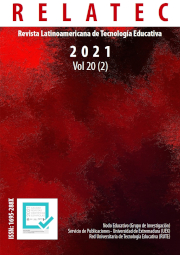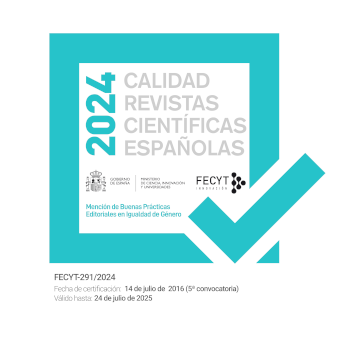Tecnologías educativas móviles colaborativas para estudiantes ciegos. Una revisión sistemática
DOI:
https://doi.org/10.17398/1695-288X.20.2.83Palabras clave:
Aprendizaje móvil, Estudiantes ciegos, Enseñanza colaborativa, Dispositivos móviles de enseñanza, Recursos didácticosResumen
Los métodos de enseñanza tradicionales pierden importancia a medida que surgen nuevas tecnologías como ayudas en el proceso de aprendizaje. Asegurar una nueva dinámica en el aula y expandir el entorno de aprendizaje más allá del aula es, de hecho, un aditivo tentador para los estudiantes que prosperan en una era de ascenso tecnológico. El aprendizaje móvil o M-learning es, por tanto, la forma más accesible y popular de ofrecer dinámicas educativas a los estudiantes, incluidos aquellos con algún tipo de discapacidad. Uniendo la enseñanza colaborativa, que permite a los estudiantes trabajar en grupo e interactivamente entre sí, y las facilidades que brinda la tecnología, el objetivo del trabajo es presentar una revisión sistemática de la literatura que señale el impacto de las tecnologías móviles colaborativas para la enseñanza de personas con discapacidad visual. Siguiendo el método de revisión sistemática de Kitchenham, se analizaron 592 artículos en portugués e inglés, 10 de los cuales fueron seleccionados para responder a las preguntas de investigación. Los resultados de esta investigación revelan que el uso de tecnologías móviles es eficiente y más accesible, impactando positivamente en el aprendizaje de los estudiantes con discapacidad visual, pero aún presenta problemas y desafíos latentes. Esta revisión sistemática proporciona a la comunidad académica una síntesis actual de la investigación y el desarrollo sobre el tema, entre 2015 y 2020, en diferentes entornos docentes, en cuanto al nivel y contexto educativo, características, receptividad y desafíos, siempre respaldado por evidencia empírica.
Descargas
Referencias
Brereton, P., Kitchenham, B. A., Budgen, D., Turner, M., & Khalil, M. (2007). Lessons from applying the systematic literature review process within the software engineering domain. Journal of Systems and Software, 80(4), 571-583.https://doi.org/10.1016/j.jss.2006.07.009
Brito, J. A., Amorim, R., De Souza Monteiro, B., Melo Filho, I. J., Gomes, A. S., De Oliveira, I. V. P., & da Rocha Seixas, L. (2017). Ubiquitous meaningful learning: Practices in the urban context. 2017 12th Iberian Conference on Information Systems and Technologies (CISTI), 1-7. https://doi.org/10.23919/CISTI.2017.7975874
Buzzi, M. C., Buzzi, M., & Leporini, B. (2012). Investigating mobile learning and accessibility for blind users. Mobile Learning for Visually Impaired People, 26.
Campbell, L. (2017). You don't need eyes to see, you need vision: performative pedagogy, technology and teaching art to students with vision impairment. Journal of Pedagogic Development, 7(3), 3-12.
Chinthaka, W., & Abeygunawardhana, P. (2018). Cbeyond: Mathematical Learning Tool for Primary Level Visual Impaired Students. 2018 13th International Conference on Computer Science & Education (ICCSE). https://doi.org/10.1109/ICCSE.2018.8468805
Crompton, H., & Burke, D. (2018). The use of mobile learning in higher education: A systematic review. Computers & Education, 123, 53-64. https://doi.org/10.1016/j.compedu.2018.04.007
Eguavoen, E. O. (2016). ICT Utilization As Correlates Of Academic Performance Among Students With Visual Impairment In Lagos State, Nigeria. European Scientific Journal, ESJ, 12(13), 205-205. https://doi.org/10.19044/esj.2016.v12n13p205
Guinness, D., Muehlbradt, A., Szafir, D., & Kane, S. K. (2018). The Haptic Video Player: Using Mobile Robots to Create Tangible Video Annotations. Proceedings of the 2018 ACM International Conference on Interactive Surfaces and Spaces, 203-211. https://doi.org/10.1145/3279778.3279805
Kane, S. K., Shinohara, K., & Wobbrock, J. (2015). OneView: Enabling Collaboration Between Blind and Sighted Students. Undefined. https://www.semanticscholar.org/paper/OneView%3A-Enabling-Collaboration-Between-Blind-and-Kane-Shinohara/562f0ffe9a1c5f812d0d326257fc2ce436407e8a
Kinash, S., Crichton, S., & Kim-Rupnow, W. S. (2004). A Review of 2000-2003 Literature at the Intersection of Online Learning and Disability. American Journal of Distance Education, 18(1), 5-19. https://doi.org/10.1207/s15389286ajde1801_2
MacLure, K., Paudyal, V., & Stewart, D. (2016). Reviewing the literature, how systematic is systematic? International Journal of Clinical Pharmacy, 38(3), 685-694. https://doi.org/10.1007/s11096-016-0288-3
Moloo, R. K., Khedo, K. K., & Prabhakar, T. V. (2018). Critical evaluation of existing audio learning systems using a proposed TOL model. Computers & Education, 117, 102-115. https://doi.org/10.1016/j.compedu.2017.10.004
Pacheco, E., Yoong, P., & Lips, M. (2017). The Role of ICTs in Students with Vision Impairments’ Transition to University (SSRN Scholarly Paper ID 3128786). Social Science Research Network. https://papers.ssrn.com/abstract=3128786
Pacheco, E., Yoong, P., & Lips, M. (2017, mayo 1). The Role of ICTs in Students with Vision Impairments’ Transition to University. International Conference on Information Resources Management - CONF-IRM2017, Rochester, NY. https://ssrn.com/abstract=3128786
Pesek, M., Kuhl, D., Baloh, M., & Marolt, M. (2015). ZaznajSpoznaj—A modifiable platform for accessibility and inclusion of visually-impaired elementary school children. Proceedings of the International Conference on Informatics in Schools—ISSEP 2015, 173-179. https://core.ac.uk/download/pdf/151478405.pdf#page=179ç
Rauch, M. (2011). Mobile documentation: Usability guidelines, and considerations for providing documentation on Kindle, tablets, and smartphones. 2011 IEEE International Professional Communication Conference, 1-13. https://doi.org/10.1109/IPCC.2011.6087221
Ravindran, V., & Shankar, S. (2015). Systematic reviews and meta-analysis demystified. Indian Journal of Rheumatology, 10(2), 89-94. https://doi.org/10.1016/j.injr.2015.04.003
Setiawan, D., Priambodo, B., Anasanti, M. D., Hazidar, A. H., Naf’an, E., Masril, M., Handriani, I., Nseaf, A. K., & Putra, Z. P. (2019). Designing a Multimodal Graph System to Support Non-Visual Interpretation of Graphical Information. Journal of Physics: Conference Series, 1339(1), 012059. https://doi.org/10.1088/1742-6596/1339/1/012059
Shi, L., Zhao, Y., & Azenkot, S. (2017). Markit and Talkit: A Low-Barrier Toolkit to Augment 3D Printed Models with Audio Annotations. Proceedings of the 30th Annual ACM Symposium on User Interface Software and Technology, 493-506. https://doi.org/10.1145/3126594.3126650
Zhang, L., & Nouri, J. (2018, abril). A Systematic Review of Learning and Teaching with Tablets. 14th International Conference Mobile Learning. https://eric.ed.gov/?id=ED590394
Descargas
Publicado
Número
Sección
Licencia
Los autores/as que publiquen en esta revista aceptan las siguientes condiciones:
1. Los autores/as conservan los derechos de autor y ceden a la revista el derecho de la primera publicación, con el trabajo registrado con la licencia Creative Commons Reconocimiento-NoComercial-SinObraDerivada 4.0 International (CC BY-NC-ND), que permite a terceros utilizar lo publicado siempre que mencionen la autoría del trabajo y a la primera publicación en esta revista.
2. Los autores/as pueden realizar otros acuerdos contractuales independientes y adicionales para la distribución no exclusiva de la versión del artículo publicado en esta revista (p. ej., incluirlo en un repositorio institucional o publicarlo en un libro) siempre que indiquen claramente que el trabajo se publicó por primera vez en esta revista.
3. Se permite y recomienda a los autores/as a publicar su trabajo en Internet (por ejemplo en páginas institucionales o personales) antes y durante el proceso de revisión y publicación, ya que puede conducir a intercambios productivos y a una mayor y más rápida difusión del trabajo publicado (vea The Effect of Open Access).









